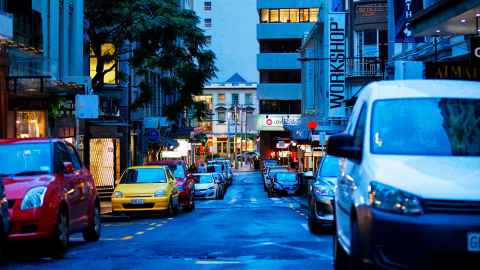Parking kills businesses, not bikes or buses
5 November 2021
Opinion: Timothy F Welch explains how digging deep to address our massive car addiction will help us meet climate goals – and may also save local businesses.

Auckland Council recently announced plans to start removing on-street parking along certain arterials. The move, as expected, garnered an immediate and visceral response from many groups, but perhaps none so vocal as business associations. The groups were alarmed by the potential impact such a move might have on local businesses. The typical war cry – with some paraphrasing – rang out, “removing parking will kill local businesses”.
Understandably, such groups and business owners are concerned about the policy. Many business owners believe that a significant portion of their patronage arrives by car, and thus removing parking will force customers to shop elsewhere. This perception is common, but it is also misguided.
Studies from across the globe have found that shop owners consistently overestimate the number of shoppers that arrive by car and vastly underestimate the number of people who arrive by other modes.
In a study of Parkdale Village in Toronto, a quarter of business owners estimated that over half their customers drove to their business – in reality, just 4 percent drive. The rest biked, walked or took public transport.
This misconception often occurs because business owners overestimate how far people travel to shop in their stores. A study in Berlin found that shop owners believed only about 12 percent of customers lived within 1km of a shopping street when more than 51 percent of customers lived within that walkable distance. Local shops attract local customers, and those customers rarely drive.
Both the Toronto and Berlin studies found that people on foot, on bikes or taking public transport spend more money when they go to local shops and visit much more often than those who travel by car. In the case of Berlin, people who did not drive were responsible for more than 90 percent of weekly spending.
Replacing kerb-side parking with bus or bike lanes does not hurt local businesses, and in some cases, it can increase patronage. Bikes and buses don’t kill businesses - parking does.
In addition to being relatively unimportant to local business, on-street parking can be wasteful and harmful. The availability of free or under-priced parking encourages excessive auto-travel. During the few peak periods when most of the on-street parking is in use, drivers will circle the block searching for a free or cheap car park in a behaviour known as cruising, which adds to congestion and increases vehicle emissions.
People parking vehicles and getting in and out of those cars pose a significant risk to people on bikes. Bike lanes are typically painted between moving traffic and kerb-side parking. When drivers dart in and out of parking spaces, they can neglect to look for cyclists or not see them approaching, leading to serious vehicle-cyclist collisions. Even more common, drivers often fail to check their mirrors before opening their door; this can lead to cyclists hitting the door and suffering severe injuries or even death in an event known as dooring.
Kerbs, like streets, are public spaces and should be put to use to benefit the greatest number of people. On-street parking benefits a couple of dozen individuals. Dedicated bus lanes and protected bike lanes benefit many thousands of people, including drivers. A single 1.8m bike lane can accommodate 12,000 people per hour, and a local bus lane can carry up to 5000 people per hour.
Many people view parking in front of their residences as their space. However, property ownership ends at the berm, long before reaching the area reserved for on-street parking. Expecting free parking in front of one’s house is like cordoning off a section of the beach and never allowing anyone to enter. The space along the kerb belongs to all of us. We should use it in a way that benefits all of us.
Cars spend the vast majority of their lives parked. More than 95 percent of the time, cars are simply parked in one location or another. Given that New Zealand has the fourth highest number of cars per capita in the world (about 837 vehicles per 1000 people), it’s no wonder we get so upset about parking – our vehicles need a lot of it, a lot of the time.
Parking is, however, just a symptom of our massive car addiction. Removing parking addresses one of these symptoms, but at the same time, we should be working to address the underlying issues causing our parking woes, which include land uses that have spread out so far that we need a car to complete our daily activities; systematic underinvestment in public transportation and infrastructure for active modes; under-pricing driving and infrastructure (including parking); and over-investment in roads of all kinds.
AT’s update to their 2015 Parking Strategy is a move in the right direction, but if we want to meet our climate goals - the stated purpose of this new policy approach - we’ll need to dig much deeper to treat our addiction. In doing so, we may yet save local businesses.
Dr Timothy F. Welch is a senior lecturer in the School of Architecture and Planning at the Faculty ofCreative Arts and Industries.
This article reflects the opinion of the author and not necessarily the views of the University of Auckland.
Used with permission from Parking kills businesses, not bikes or buses 5 November 2021.
Media queries
Alison Sims | Media adviser
DDI 09 923 4953
Mob 021 249 0089
Email alison.sims@auckland.ac.nz